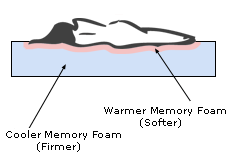Foam ILD Ratings
Contents
Most people think that density is what makes mattress toppers and beds soft or firm. This is not exactly true. You can have very soft or very firm high-density visco foam.
The firmness or softness of a memory topper is determined by the ILD/IFD rating (Indentation Load Deflection, Indentation Force Deflection). The best memory foam beds have the unique ability to change that firmness but first, let’s see why ILD ratings are important and how you can use them to pick a good mattress.
Understanding Firmness Ratings
Some websites say that ILD reflects the ability of viscoelastic foam to push back against the force pressing down on it. This is not true. Unlike other types of foams, memory bed foam does not push back.
What memory ILD ratings do measure is the force needed to press a disc into a visco foam slab. The higher the rating, the firmer the feel of the memory foam topper, the lower the rating, the softer the feel.
Firmness ratings range from super soft 10 to semi-rigid 120. Toppers made of lower ILD material conform better to your body and can distribute weight more efficiently in order to relieve pressure.
Very low ILD foam toppers, however, are too soft to provide adequate support. ILD ratings determine how easily they will shape to your body and how much support it is capable of giving.
Well-known manufacturers like Tempur-Pedic and others understand the importance of firmness in a mattress. They also understand that too firm or too soft a bed can make sleeping uncomfortable. This is where things get remarkable.
Tempurpedic uses temperature responsiveness to adjust the firmness of a memory foam bed to your body, without taking away support. This is the appealing memory effect you may have seen in TV adverts. Unfortunately, the visco foam needed for Tempur beds is more expensive to make because they use more sophisticated materials.
The Only Reason Why You Should Buy A Genuine Memory Bed
Many people sleep poorly because their bed is too soft or too firm. A hard foam bed creates pressure points and reduces circulation. The muscles must work harder to keep the spine straight. If the bed is too soft, then the spine sags out of alignment leading to back and neck pains. But toppers and beds made of good, heat-responsive visco foam react a little differently.
Visco memory foam has the amazing ability to change its firmness rating at body temperature. It feels firmer (has a higher ILD number) at cooler temperatures — this is where support comes from — and feels softer (has a lower ILD number) at higher temperatures — this is where the gentle contouring of the body comes from.
You should only look for a foam bed that’s heat-responsive. This makes it both soft and firm. Good memory foam lets the body sink in rather deeply, but not too much, while still maintaining the support of a firm bed. Here’s how it works.
As you lie down on a firm, good quality viscoelastic topper or Tempurpedic bed, it readily reacts to your temperature and begins to soften, becoming a temporary extension that flows around your body.
Memory foam melts become soft and gentle around your body where it’s warmer but the rest of the bed remains cooler (from as little as 3/8 inch lower down) and keeps its resilience to provide good support.

The ability to change firmness actually improves support and comfort. The firmness and density of the cooler foam deeper in the bed hold you up. But increased support also comes from the foam’s heat responsiveness. The viscoelastic foam bed or topper softens at body temperature and makes up to 30% more body contact, thus improving weight distribution over a wider area.
Generally speaking
- Higher-density memory foam toppers are firmer because of the better quality resin used to make them. But this may not always be the case. You may come across firm, low-density toppers.
- High density visco foam like the one used to make Tempurpedic beds perform better as long as their firmness reacts to body temperature and adjusts in order to improve weight distribution and relieve pressure.

